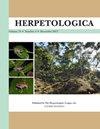落叶之下:蝾螈的个性会影响森林地面的动态吗?
IF 1.1
3区 生物学
Q2 ZOOLOGY
引用次数: 0
摘要
摘要生态学研究证明了种内表型变异如何对群落动态产生影响。然而,动物个性(即种内行为变化)对生态过程的影响仍然相对缺乏研究。以红背蝾螈(Plethodon cinereus)和碎屑食物网为模型系统,我们进行了一项实验室中尺度实验,以探索顶级捕食者的性格类型是否会影响复杂的陆地食物网中的群落结构。我们使用行为分析来研究蝾螈行为的可重复性,并将个体分为活跃或不活跃。然后,我们让实验室中尺度动物接受四种处理中的一种,为期3个月:一种活性蝾螈,一种非活性蝾螈、对照(无蝾螈)和实验前参考。我们的研究结果表明,灰螈对碎屑食物网的影响可能是行为介导的,只有最活跃的蝾螈才会影响群落结构。具体而言,与所有其他治疗方法相比,生活在活跃蝾螈体内的中尺度无脊椎动物群落的多样性较低。这种差异主要是由弹尾鱼引起的,弹尾鱼在活跃蝾螈的中尺度内更为丰富。我们还发现,蝾螈的个性与中尺度内盖板的使用有关,不活跃的蝾螈比活跃的个体对盖板的使用更具文献学意义。不同处理的落叶层降解没有差异,这表明蝾螈的生态效应太弱,无法影响碎屑食物网中的基础资源。我们的研究提出了关于动物个性影响陆地群落生态过程的潜力的进一步问题。本文章由计算机程序翻译,如有差异,请以英文原文为准。
Beneath the Leaf-Litter: Can Salamander Personality Influence Forest-Floor Dynamics?
Abstract Ecological research demonstrates how intraspecific phenotypic variation can have consequences for community dynamics. However, the effects of animal personalities (i.e., intraspecific behavioral variation) on ecological processes remains relatively understudied. Using Red-backed Salamanders (Plethodon cinereus) and the detrital food web as a model system, we conducted a laboratory mesocosm experiment to explore whether or not the personality type of a top-level predator could affect the community structure within a complex, terrestrial food web. We used behavioral assays to investigate the repeatability of salamander behaviors, and classified individuals as either active or inactive. We then subjected laboratory mesocosms to one of four treatments for 3 mo: one active salamander, one inactive salamander, control (no salamander), and a pre-experimental reference. Our results indicate that the effect of P. cinereus on the detrital food web might be behaviorally mediated, with only the most active salamanders affecting community structure. Specifically, mesocosms housing active salamanders contained less diverse invertebrate communities than all other treatments. This difference was primarily driven by springtails, which were more abundant within mesocosms housing active salamanders. We also found that salamander personality was associated with cover board use inside mesocosms, with inactive salamanders exhibiting a more philopatric use of cover objects than active individuals. Leaf-litter degradation did not differ between treatments, indicating that the ecological effects of salamanders were too weak to influence basal resources within the detrital food web. Our study prompts further questions regarding the potential for animal personalities to influence ecological processes within terrestrial communities.
求助全文
通过发布文献求助,成功后即可免费获取论文全文。
去求助
来源期刊

Herpetologica
生物-动物学
CiteScore
4.60
自引率
0.00%
发文量
27
审稿时长
>12 weeks
期刊介绍:
Established in 1936, Herpetologica is a quarterly peer-reviewed journal serving herpetologists, biologists, ecologists, conservationists, researchers and the scientific community. The journal contains original research papers and essays about the biology of reptiles and amphibians, and covers many relevant topics including: behavior, conservation, ecology, genetics, morphology, physiology and taxonomy.
 求助内容:
求助内容: 应助结果提醒方式:
应助结果提醒方式:


